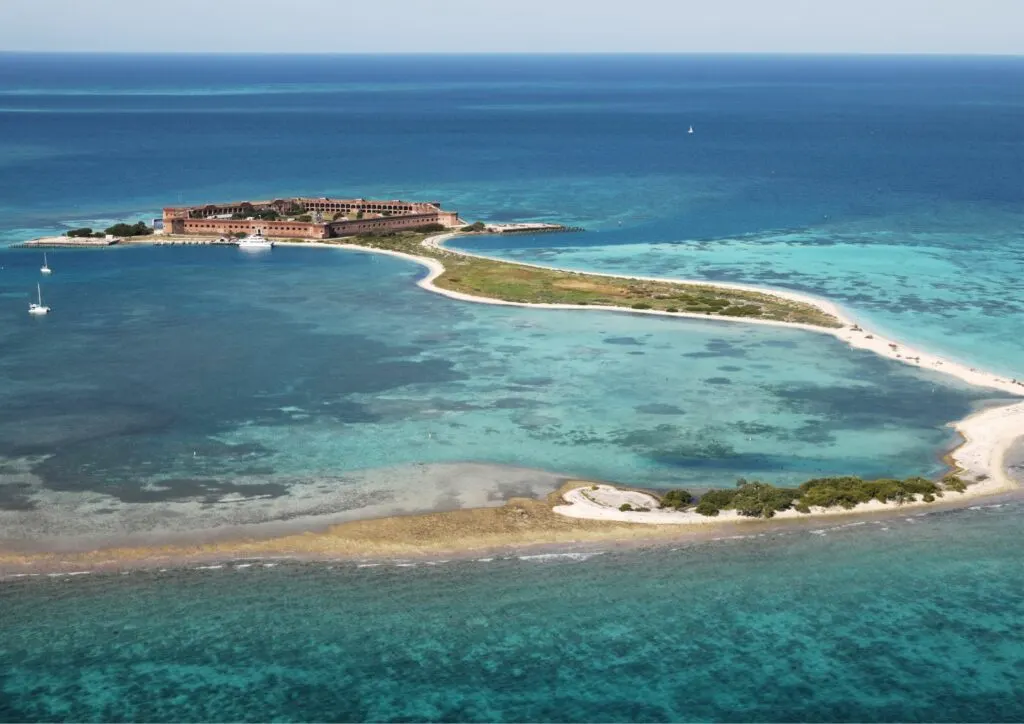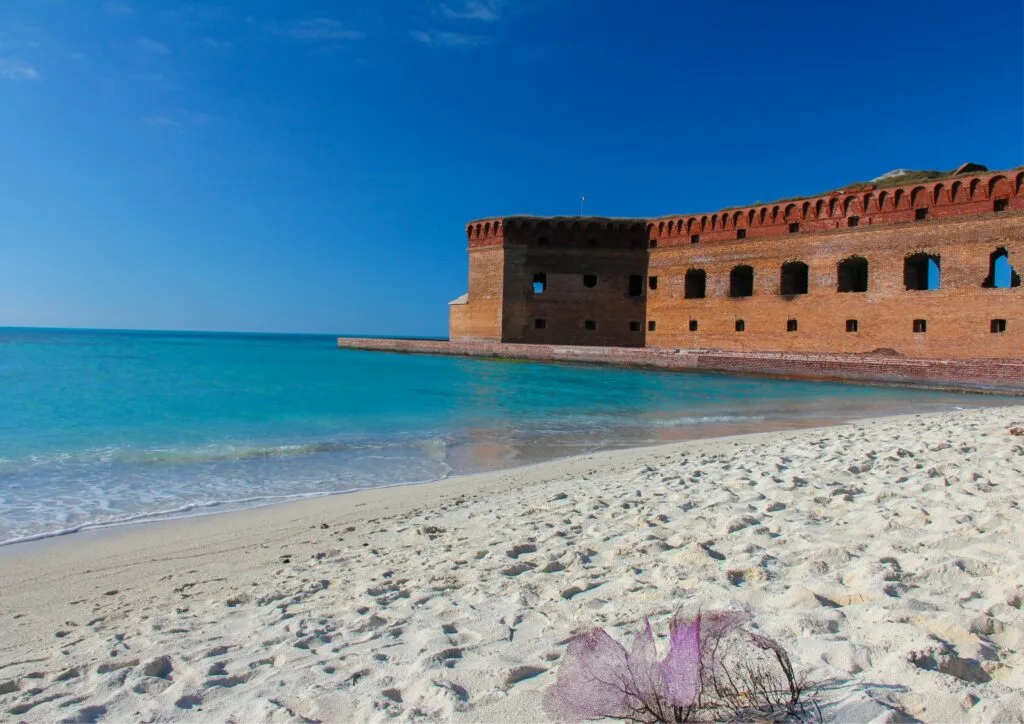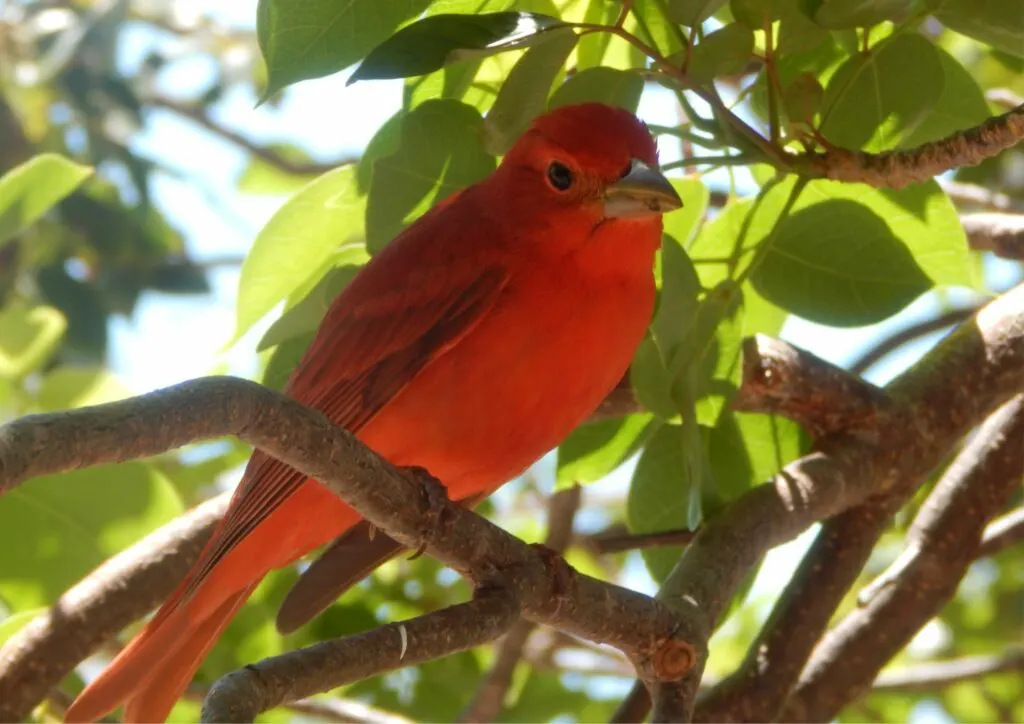With crystalline waters that stretch for miles to meet the blue sky at the horizon, abundant marine life, and beautiful beaches, Dry Tortugas National Park invites adventurers and holidaymakers from around the world. To help you plan your holiday better and create everlasting memories, we will discuss everything you need to know about the Dry Tortugas.
About Dry Tortugas National Park

Located in the Gulf of Mexico at a distance of 68 miles, Dry Tortugas National Park encompasses seven Florida Keys islands. More than 90% of the park consists of water. The parks’ islands are Garden Key, Bush Key, Loggerhead Key, Hospital Key, Long Key, East Key, and Middle Key. In total, the park occupies 104 acres, and within the park is the preserved Fort Jefferson.
Thriving marine life, coral reefs, sunken treasures, and shipwrecks are some of the key highlights of the park; the park also renders a tropical environment suitable for birds. Also, the park occupies a part of the Everglades & Dry Tortugas Biosphere Reserve.
The islands have low elevation and irregular geographical characteristics. Certain areas of the park are known for their thick vegetation and the growth of mangroves, while some areas are devoid of vegetation apart from small patches of grass. Some islets disappear and reappear, which is the result of hurricanes.
Tourists find plenty of things to do and see here. Diving, snorkelling, birdwatching, fishing, and exploring historical attractions are among the things you can do.
You might also be interested in: Places to Visit in Key West
What are Dry Tortugas Mostly Known for?
Dry Tortugas National Park is known for its various attractions, but the main highlight is Fort Jefferson. Rivalling the fort are several other tourist attractions, including shipwrecks, sunken treasures, bird breeding grounds, beaches, and last but not least, enchanting marine life.
Dry Tortugas History

The islands were first discovered in 1513 by Juan Ponce de León, a Spanish explorer. He was able to catch 160 turtles here, hence the name ‘Tortugas’, which translates to ‘turtle’. The part ‘dry’ was derived from the fact that the islands lacked surface fresh water.
The archipelago is home to a number of shipwrecks that date from the 17th century. In 1989, a sunken ship was discovered, which is thought to be part of the Spanish treasure fleet in 1622; the items retrieved from the ship include copper, silver, gold, cultural artefacts, and olive jars.
And in 1985, another wreck was discovered, which yielded a cache worth $450 million; the treasure comprised tons of gold, silver, Spanish coins, and emeralds – the treasure is known as The Atocha Motherlode.
Fort Jefferson
The largest structure of its kind in the Western Hemisphere, Fort Jefferson, is an incomplete coastal fortress; the Fort is built with over 16 million bricks. This was once a prison that held Dr Samuel Mudd, who was known for treating John Wilkes Booth, the man who assassinated Abraham Lincoln.
From 1846 to1875, it took nearly 30 years to build the park, but it never reached completion. Nevertheless, the park served its intended purpose of fortifying the harbour. For ships, the harbour provided refuge from storms – the Dry Tortugas lie near one of the most-travelled shipping lanes.
Park
In 1935, the Fort was designated a national monument. In 1992, the monument was established as Dry Tortugas National Park. The park is under the administration of Everglades National Park. The purpose of the park is to preserve Fort Jefferson and protect the marine ecosystem along with the submerged treasures.
Wildlife
The Dry Tortugas feature a subtropical ecosystem, creating a habitat for species that are not found anywhere else in the United States. You can find 299 bird species here, and eight of these species nest within the islands. In the month of April, bird migratory activities peak and so do tourist visits.
During this time, you can see dozens of migratory birds pass through the park within the course of a single day. Some birds land within Fort Jefferson.
Climate
The climate of the Dry Tortugas is characterized by tropical savannah climate conditions. A dry season and a rainy season can be witnessed. The rainy season, which occurs in the same period as the Atlantic hurricane season, extends from May to October, and the dry season is from November to April. Forest canopy and jungle terrains aren’t seen on the islands, which results in the hot temperatures caused by direct sun exposure.
What is the Best Month to Visit Dry Tortugas?
June to November, the summer season, is the best time to visit Dry Tortugas. This is also the Atlantic hurricane season. There can be occasional hurricanes and storms, but for the most part, you’ll get stable climate conditions, with clear skies and minimal winds. The period extending from April to June, the spring season, is also considered a good time to visit.
As the Dry Tortugas feature tropical climate conditions with unexpected rainfall, we suggest you check the weather report before visiting the park.
Things to do at Dry Tortugas
Your time here at Dry Tortugas National Park will be filled with adventure. There are so many things you can do.
Dry Tortugas Snorkelling
You’ll find several snorkelling sites within the park, but the most popular is Windjammer, a shipwreck with a history going back to 1901. The shallow waters of the park make snorkelling a fun activity for all ages.
Here are the best spots for snorkelling in the Dry Tortugas:
| Island | Snorkelling Site | Highlights and Things to Know |
| Garden Key | Coral Heads Snorkelling Site | You’ll see a number of tropical fish species and corals |
| Garden Key | Moat Wall at Fort Jefferson | Perfect for families with kids, the site offers night snorkelling. Tropical and corals are the main highlights |
| Garden Key | North and South Coaling Pier Pilings | The pier was built in the 1880s, and a hurricane laid ruin to the pier. Snorkellers can see large game fish like barracuda, shark, and tarpon |
| Garden Key | Texas Rock | Located within the park, the site has a depth of 55 metres. Crystal clear waters, corals, and tropical fish offer experienced snorkellers and divers a wonderful time |
| Loggerhead Key | Little Africa Reef | The site offers year-round access. Perfect for beginners and children, the site is known for beautiful coral heads and tropical fish |
| Loggerhead Key | Windjammer | The site is also known as Avanti Shipwreck. With a depth of 20 feet, the site brings beginners an amazing experience. Only day snorkelling is allowed. The highlights include corals and tropical fish |
| Long Key | Long Key Reef | You cannot access the island; visitors should stay off the shore. The depth spans from 35 to 65 feet, and coral formations are the highlight. |
| East Boundary of the Park | Pulaski Shoals | Home to numerous shipwrecks, the site is known for strong currents; shark species are known to travel the waters here. Snorkellers are advised to stay in the shallow waters. |
It’s important to remember that you should never touch coral reefs or fish or disturb marine life by flashing blinding lights.
Dry Tortugas Camping
There’s only one island that allows camping, and that is Garden Key, where you find Fort Jefferson. Although the campsites here aren’t well-equipped, you are sure to have fun. Tables and grills are provided, but you may have to share the campground with other campers.
Kayaking
Kayaking in the Dry Tortugas is bound to be fun. You can explore the shallow waters of Garden Key, Bush, and Long Key on a paddleboat or a kayak. Paddling to Loggerhead Key from Garden Key takes about three hours. You will be offered a range of kayaking and paddling tours that involve other activities like snorkelling.
Saltwater Fishing
Enjoy fishing during your time in the Dry Tortugas. The abundant and thriving marine life has made the activity fun and gratifying. You need a permit to fish here, and there are certain regulations you need to follow; for instance, spearfishing isn’t allowed, and you cannot catch lobsters.
Cultural Attractions
Use your holiday in the Dry Tortugas to embark on a cultural tour. You can explore Fort Jefferson and learn about its history. Also, make sure you have time to explore the shipwrecks.
Beaches
Whether you want to relax under the palm trees, sunbathe or swim, beaches in the Dry Tortugas will offer you exactly what you want.
See Wildlife
The Dry Tortugas are a haven for bird lovers. A wide range of bird species are spotted here, and during the migration period, you’ll be able to see a number of rare bird species.
In addition to birds, you can also see sea turtles and a range of tropical fish species hidden among the vibrant coral reefs.

Frequently Asked Questions about Dry Tortugas
How much is a day trip to Dry Tortugas?
The cost of a day trip varies according to visitor categories. However, for an adult, it shouldn’t cost more than USD 200.
Can you spend the night at Dry Tortugas?
Yes. Overnight stays are allowed in the designated area near Fort Jefferson. Night camping here is fun and delightful. You can watch the sunset, stargaze, and enjoy some night snorkelling and diving.
How much time do I need at Dry Tortugas?
It depends on the activities you have planned for your tour. On a day trip, you can spend the whole day here, exploring Fort Jefferson and enjoying the various water sports. You can, of course, camp here at night, which means that you’ll end up spending a whole night. Most visitors spend at least four hours on the islands.
What should I bring to Dry Tortugas?
Here’s a list of things you bring to the park with you:
- Camera
- Bathing suit
- A change of clothes
- Sunscreen, sunglasses, and sunhat
- Beach towels
- Binoculars
- Cash to buy gifts from the gift shop
- Walking shoes
- Snorkelling gear if you like to have your own
Can I bring my Dog to the Park?
Yes, you can! but dogs aren’t allowed inside Fort Jefferson.
How to get to Dry Tortugas
There aren’t any road links, so you cannot get here by car. The only available methods of transportation are by seaplane and boat. You can get here by your private boat, or choose from an array of charter tours. The Yankee Freedom Ferry is a popular choice with tourists.
How Long is the Boat ride from Key West to Dry Tortugas?
It takes about two hours and fifteen minutes to get here from Key West by boat.
How do you get to Dry Tortugas Cheap?
The Yankee Freedom Ferry is the cheapest method of transport; the ferry service is in collaboration with the park.
